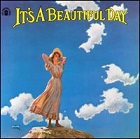 Here are five tracks from the San Francisco band, It’s A Beautiful Day, featuring classically-trained violinist, David LaFlamme, and his wife Linda Baker LaFlamme. “LaFlamme” was a stage name he chose to protect his orchestral career. Like John Lord from Deep Purple, LaFlamme understood that in the world of classical music, playing rock music is often a disqualifier.
Here are five tracks from the San Francisco band, It’s A Beautiful Day, featuring classically-trained violinist, David LaFlamme, and his wife Linda Baker LaFlamme. “LaFlamme” was a stage name he chose to protect his orchestral career. Like John Lord from Deep Purple, LaFlamme understood that in the world of classical music, playing rock music is often a disqualifier.
Their 1969 self-titled album is arguably the best of the 60s psychadelic-rock albums. It was more artistically ambitious than Jefferson Airplane’s Surrealistic Pillow. Male/female vocal duets, combined with electric violin and organ contributed to the band’s unique sound. Because their songs require all of those elements, cover bands almost never attempt any music from this album.
Call it pretentious. Like much music from this era, it was. It’s still an artistic triumph, and it was hugely popular. At the time, it was hard to find anyone who had heard it who didn’t like it. The engineering was good. The arranging and much of the writing are excellent. “White Bird” and “Hot Summer Days” were long-running FM radio hits. Because they ran together on the album, “Bombay Calling,” “Bulgaria” and “Time Is” were usually played together as one 20-minute set. (The only other album side that FM programmers regularly played through uninterrupted was the Beatles’ Abbey Road.)
The studio versions of these songs are much better than the live versions. In concert, they consistently played all of their songs faster than the studio versions. Like most arrangements, these arrangements fall apart if you push the tempo too much. Some of their live tempos were over-the-top fast. (Like, what were they thinking?)
Because of some licensing hang-up, this album used to be impossible to find in record stores. You had to special-order an import, at three or four times the average cost. So most people only heard it was on radio. The album received a generous amount of airplay on AOR (“album-oriented rock” or “adult-oriented rock”) stations nationwide. In Dallas, both KNUS and KZEW played the songs listed below many hundreds of times – enough that I had memorized them. This 1969 album remained popular on FM radio for more than a decade.
David LaFlamme: “There had been a lot of interest in me becoming a member of the Utah Symphony there. I had played with the Symphony again I had won a couple of different competitions and because of the competitions I was invited to play with the Symphony as a soloist. To me the world of Classical music was at that point was mostly a lot of old people and I was very young, very spirited and really interested in a lot more kinds of music than just heavy classical music which I had played a lot of all of my life. So I set out on this musical odyssey, I guess you could call it, to discover and play with a lot of different types of musicians and a lot of different types of music in San Francisco.”
Above quote from: David LaFlame as interviewed by John Barthel (from roadhogs.net on Wayback Machine)
YouTube Song Links:
On FM radio, these three songs were almost always played as a set:
Bombay Calling / Bulgaria / Time Is
Not included: “Girl With No Eyes,” and “Wasted Union Blues.” Girl is interesting, but it was never my favorite. Wasted is, in my opinion, an aptly-named throw-away cut. Maybe they ran out of material in the studio.
Radio Station Playlists
KNUS 98.7 FM DALLAS – A recreation of KNUS FM in Dallas from 1968 to 1973.
KZEW 98 FM DALLAS – A recreation of Dallas radio station KZEW circa 1977, and earlier. Features the best from 1973 to 1977. KZEW also played many songs from the KNUS playlist. Songs in the KNUS playlist are *not* repeated in the KZEW playlist.